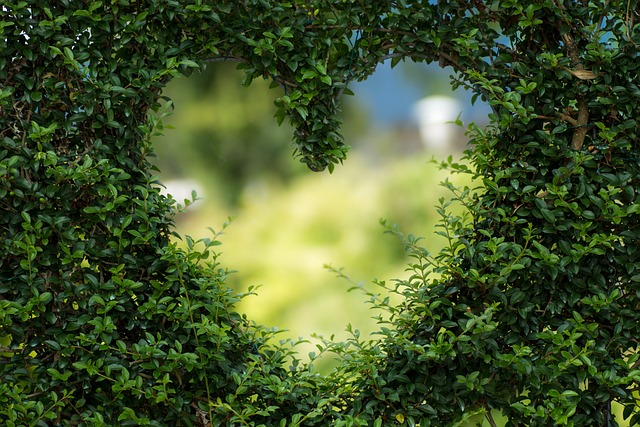You don’t need to be a professional designer or landscaper to appreciate the Great British garden.
But as with most things, your beautiful garden starts with careful planning and great garden design.
At Landscaping Superstore, our customers often ask us:
How can I make my garden attractive?
To lend a hand with some garden inspiration, we decided to take a deep dive into the latest garden design ideas and garden landscaping ideas popular with the engaged homeowner in the UK right now.
We’ll help you understand the main principles of landscape garden design and how you can put them to good use to transform your humble garden into an enchanting oasis of relaxation and recreation.
Here’s what we’re going to cover.
Table of contents:
- What are the seven principles of landscape design?
- Look after the lawn
- Attract wildlife with the right plants
- Focalise with a summer house
- Balance with decking
- Connect with garden paths
- Compartmentalise with hedges
- Create an outside living room
- Integrate garden ornaments
- Get the right garden lighting
- Create a gravel garden
- Paint your fence for contrast
- Bring warmth & elegance with a chiminea
- Embrace height with a trellis or pergola
- Create a holiday vibe with a hot tub
- Entertain in style with a garden bar
- Making the most of the latest garden landscaping ideas
What are the seven principles of landscape design?
A sound understanding of the main principles of landscaping will help you contextualise general landscaping ideas and allow you to implement them in the right way. These principles can serve as guidelines to create visually appealing and harmonious outdoor spaces.
There are various interpretations and formulations of the principles, but a commonly accepted set of seven principles includes unity or harmony, balance, scale or proportion, rhythm, focalisation or focal point, contrast and simplicity.
Let’s take a closer look at each one in turn.

Unity/harmony
This principle emphasises creating a sense of cohesion and balance throughout the landscape. It involves using consistent themes, elements and styles to tie the different parts of the design together, giving the landscape a unified appearance.
Balance
Achieving balance involves distributing visual weight evenly across the landscape. In terms of modern garden design, there are two types of balance:
With symmetrical balance, elements are mirrored on either side of a central axis, creating a formal and structured appearance.
With asymmetrical balance, on the other hand, different elements with similar visual weight are balanced through careful arrangement, resulting in a more informal and dynamic look.
Proportion/scale
Proportion refers to the relationship between the sizes of various elements in the landscape design. It involves ensuring that each element’s size is right for the overall space and other elements around it. Proper scaling ensures that one element doesn’t dominate or get overshadowed by others.
Rhythm
Rhythm in garden planning ideas involves the repetitive use of certain elements or design motifs to create a sense of movement and flow within the landscape. You can achieve this through the strategic placement of plants, hardscaping or other design features.
Focal point
A focal point is a central element or area in the landscape that draws immediate attention. It serves as a visual anchor and helps create interest and depth in the design. Common focal points include statues, water features, specimen plants or unique architectural elements.
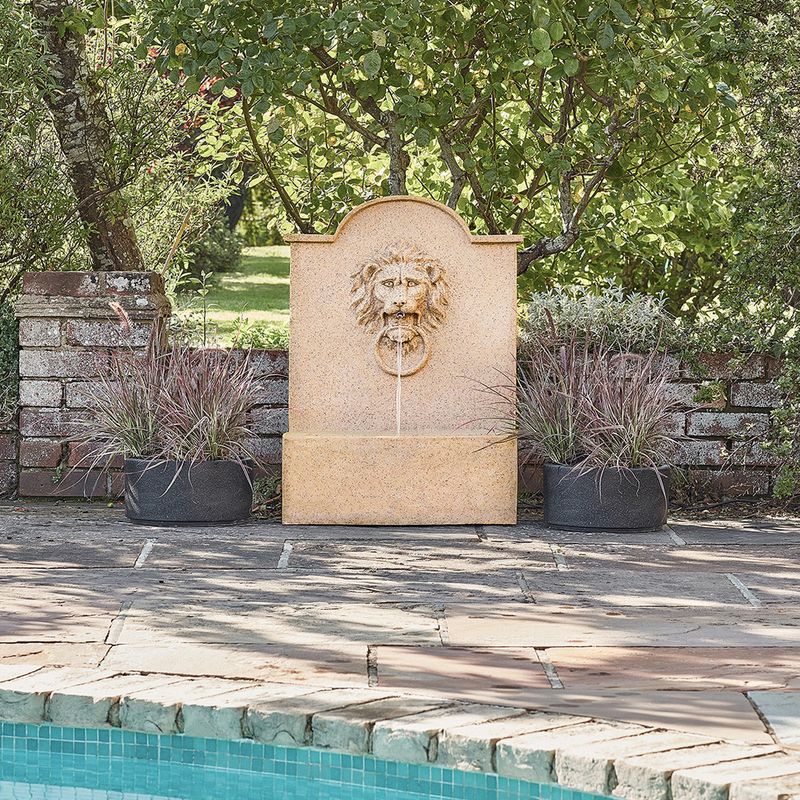
Contrast
Contrast is about using differences in colours, textures, shapes or sizes to create visual interest and make elements stand out. Some examples are having contrasting plant shapes or placing light-coloured plants against a dark backdrop.
Simplicity
Simplicity encourages avoiding clutter and unnecessary complexity in the design. It involves using straightforward and clean lines, limiting the number of different materials or elements, and focusing on essential features to create an uncluttered and elegant landscape.
Now that you know the essence of the main landscaping principles, let’s see how you can apply them in your garden in line with modern garden ideas!
1. Look after the lawn
Your garden starts with your lawn, home growing and planting. And when it comes to simple garden design ideas, so should you! Think of a well-looked-after lawn as the perfect blank canvas for your landscaping masterpiece.
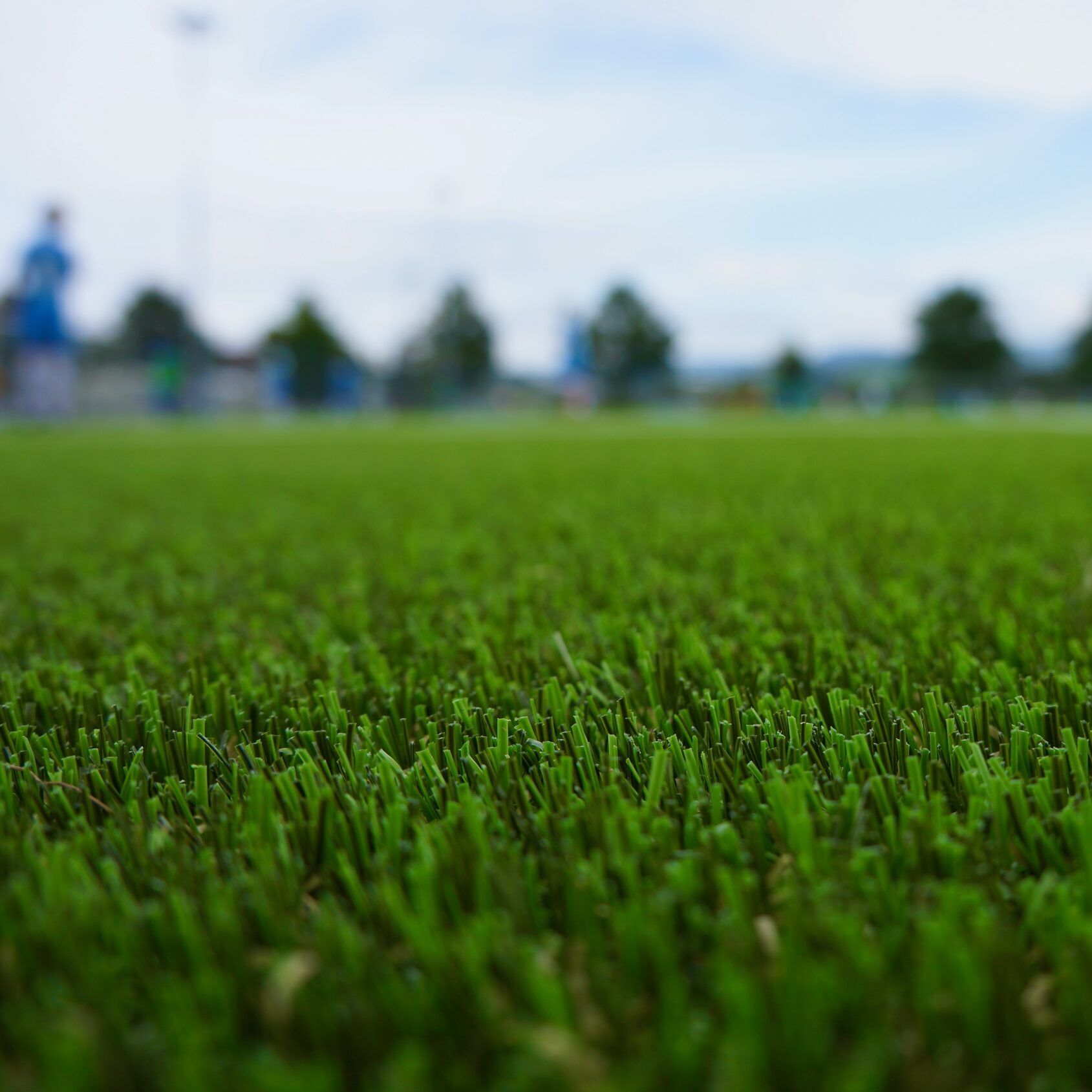
So, the first thing you should do is assess the condition of your lawn:
Is it excessively bumpy? If that’s the case, you’re going to need to level it.
Does the ground get soggy during the rainy season? You might have to consider drainage solutions, such as gravel patches (more on the benefits of gravel later).
Once you’ve fixed any outstanding issues, make sure you maintain your lawn regularly to keep it in good shape. Your lawn needs plenty of sunshine, showers and soil aeration to thrive.
While you can’t control the first of these elements completely, you can consider cutting any tree branches which shade the grass too much. During extended periods of dry weather, water your lawn first thing in the morning once a week. To aerate the soil, poke holes with a pitchfork at regular intervals.
Next:
Mowing your grass too short is another rookie mistake. Unless you’re planning on turning your garden into a golf course, all you’re doing by cutting your grass to within an inch is putting more stress on it and facilitating crown damage. Worst case scenario – you’re inviting unwanted weeds and opening the way for various diseases. Ideally, you want to mow your lawn to around three to three and a half inches.
What’s more:
Letting your grass grow wild is one of the hottest garden planting ideas right now. This brings us to our next point, namely…
2. Attract wildlife with the right plants
Great garden designs start with the right mixture of shrubs, trees and plants. When it comes to flower bed ideas, herbaceous and evergreen perennial plants like dahlias, red clover and begonias are a great way to introduce a bit of colour to complement your verdant lawn and attract wildlife.
Check this out:
If you want to attract bees, consider planting purple plants like lavender, as bees can distinguish purple better than any other colour.

To introduce birds to your outdoor space, plant climbers like honeysuckle and ivy, which provide excellent shelter for nesting birds. Make sure you keep your feathered friends coming back happily and enrich your garden with bird baths and bird feeders.
Next:
Hops will provide shelter for insects and leaves for caterpillars. As an added bonus, growing hops will allow you to brew your own beer, an increasingly popular hobby across the UK.
Last but not least, take inspiration from the latest garden planter ideas, pick the right-sized pots and use nutrient-rich soil for the best results. This way, you can combine different planters and plants to create various patterns that will wow your friends and family while attracting plenty of wildlife and helping you embrace a sustainable lifestyle.
It’s a win-win situation!
3. Focalise with a summer house
Are you seeking a unique focal point in your garden that is reminiscent of an indoor space? Or perhaps you want a personal home office with a delightful view of your property?
Either way, a summer house can be the perfect solution, offering extra space for those who cherish the outdoors.
The thing is:
Summer houses come with various applications, making it crucial to select the one that suits your needs.
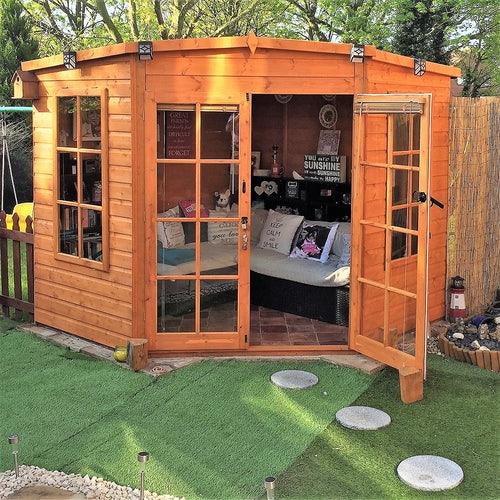
Whether you’re looking for a classic cube-style design or convenient corner options that snugly fit in the nooks of your garden, make sure you create a delicate balance between your summer house and the rest of your outdoor surroundings.
Creative gardens often feature different types of unique architectural elements, and a bespoke summer house can be both functional and eye-catching.
4. Balance with decking
Decking is a great way to introduce balance and unity to your garden and bring together its various elements. It also offers versatile applications, such as creating spaces for social gatherings, providing a clean play area for children, serving as a foundation for hot tubs or pools, and even replacing lawn space to minimise upkeep.
So, it should come as no surprise that installing decking is one of the biggest garden layout ideas at the moment.
Now:
Your intended use of the decking will significantly influence your overall planning, affecting factors like the decking’s size, material costs and the specific type of decking boards you opt for. You can find out more about that in our Decking buyer’s guide.
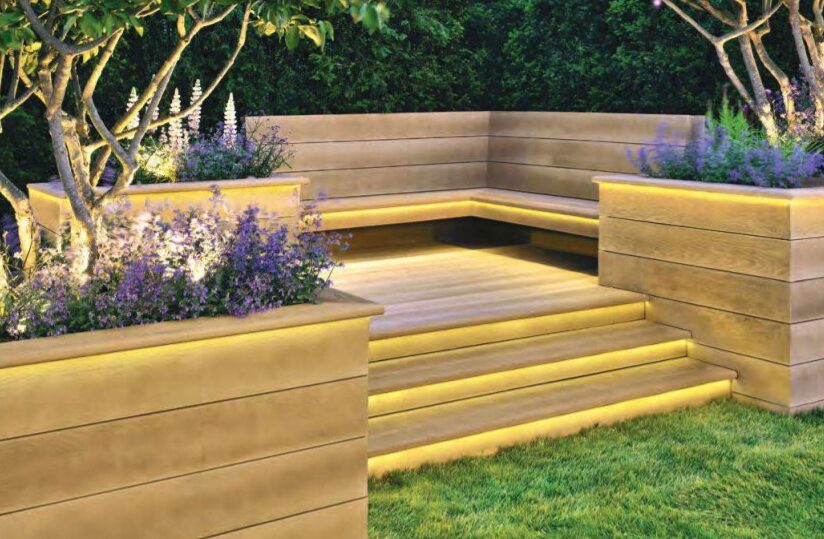
But wait – there’s more!
From a landscaping design perspective, there is also a wide range of decking layouts for you to consider. The key here is to determine which one suits your aesthetic preferences and meets the intended purpose of your decking.
Here’s the scoop:
With a horizontal/vertical decking layout, you have a classic choice for decking, where boards are laid either horizontally or vertically, depending on your orientation. A popular variation of the traditional design, the diagonal layout adds a twist while maintaining a uniform appearance.
Offering a more contemporary look, the chevron layout is a bit more complex to implement but results in a modern design that’s well worth the effort. The picture frame decking layout design is even more elaborate and eye-catching, as it involves setting a base frame of decking around the edges with diagonal decking in the centre which resembles a picture frame.
And what if you want it all?
You can always combine elements from the above designs and garden ideas to create a unique and varied style across your deck. While this may be challenging in some cases, if you have the desire and time, it can be a most rewarding endeavour.
5. Connect with garden paths
Connect the disparate landscaping features of your garden and create unity with modern garden path ideas. Keep in mind that a garden path is a long-lasting addition to any garden, which is why careful planning is essential before you start digging.
The question is:
Is your chosen location both practical and feasible?
While addressing the first part of the question involves some sketching and contemplation about your usual movements within the garden, answering the second aspect requires more thorough consideration.
It’s crucial to examine the area diligently using a cable avoidance tool. This step ensures that no underground cables are accidentally damaged during the path’s construction process.
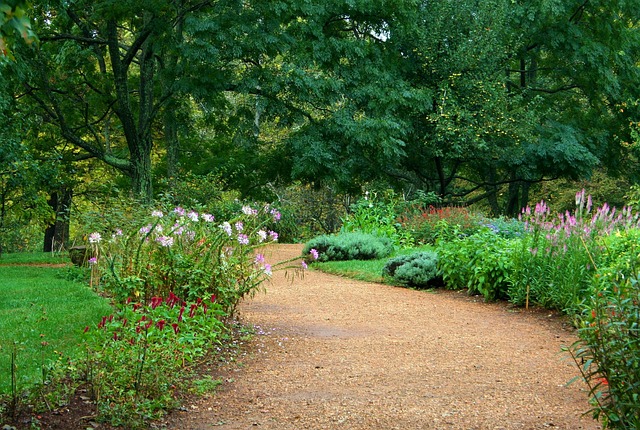
But that’s not all:
Consider what material you’re going to use. Decorative gravel is a fantastic choice, as it can easily add both texture and colour. In addition, laying a gravel path is easier than you might expect at first.
Alternatively, paving stones are a great way to create a bespoke pattern. Just as with decking, you have plenty of options to choose from. A basketweave pattern is a tried and tested solution for back gardens. Similarly, a stretcher bond pattern is ideal for curved pathways. We’re also quite fond of a Tudor pattern, which offers a seemingly random appearance.
Once again, the key here is to consider your garden paths not in isolation but in conjunction with the landscaping features they will connect.
6. Compartmentalise with hedges
If you’re lucky enough to have a large garden, you might want to compartmentalise it into smaller spaces to help create rhythm. As an added benefit, you’ll be able to introduce privacy to certain landscaping features, such as a hot tub, for instance (more on that later).
With that in mind, one of our favourite modern garden wall ideas is to use hedges for this purpose. You can even create a small labyrinth to entertain your friends and family with some Labyrinth cosplay. Your kids are going to love it!
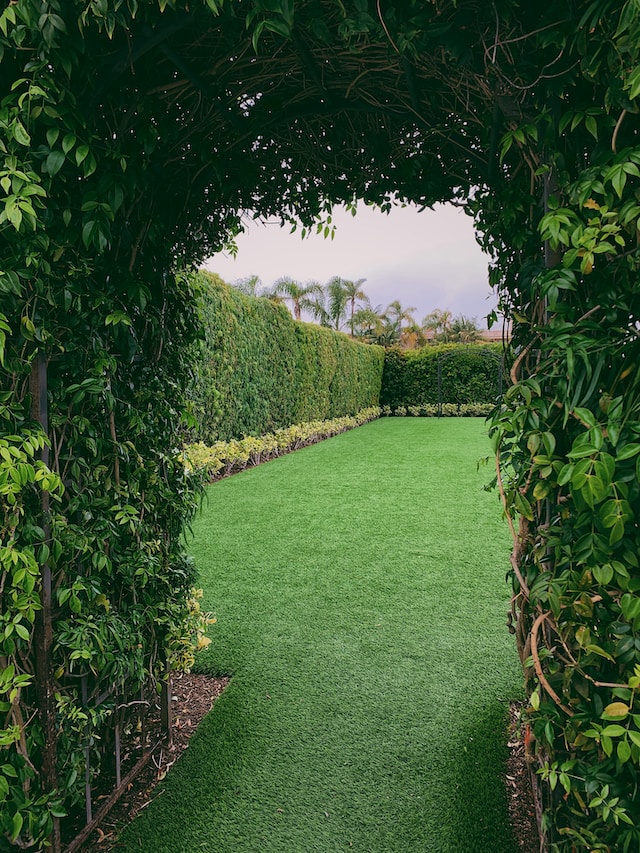
Now:
Whether or not you also use hedges instead of fences to mark the boundaries of your outdoor space is up to you. Having said that, we should add that well-groomed hedges will also complement other types of plants and provide wildlife habitat, helping you attract wildlife.
Just don’t go cutting hedges that don’t belong to you! And so that your neighbours don’t end up doing the same thing with yours, make sure you’ve checked with them before making major changes to any boundary markers you happen to share.
7. Create an outside living room
Once you’ve installed decking and/or compartmentalised a larger garden with hedges, take it to the next level by creating a living room in your garden to enjoy those longer British summer days!
How to do it? With the right garden furniture, of course!
Why not add a delightful hint of Mediterranean warmth to your garden patio with an exquisite Marbella Eight-Seater Multi-Function Set by Rowlinson, for instance? Offering more than fifteen seating configurations, this versatile garden set caters to your various needs.
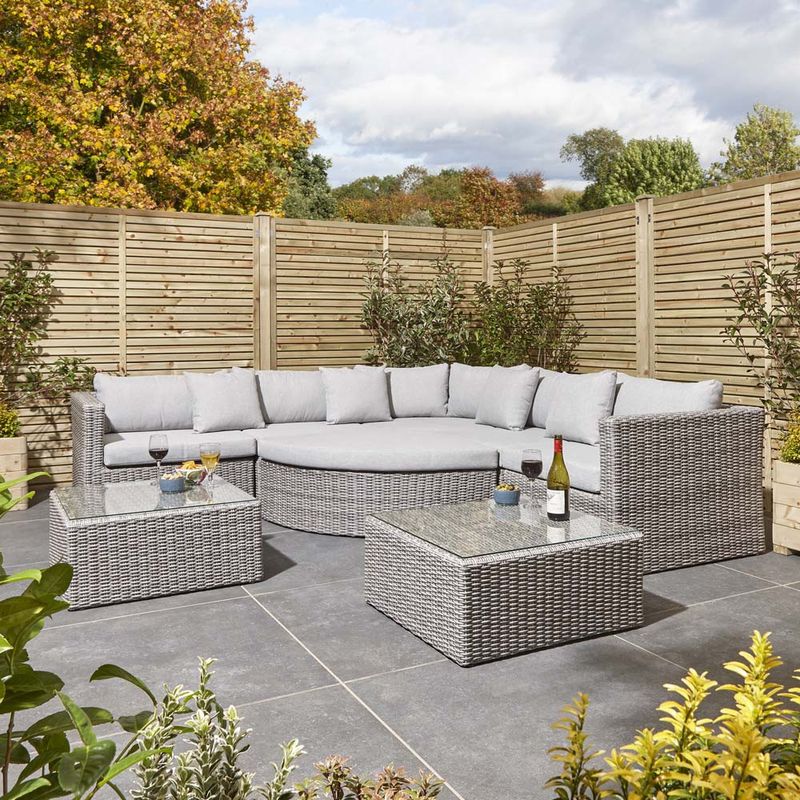
Whether you want a spacious and cosy lounger for relaxation or seek ample seating for hosting multiple guests at a family garden gathering, similar sets ensure you are well-equipped for every occasion.
Alternatively, opt for classic timber benches to go alongside your garden bar to create the ultimate beer garden!
Key takeaway:
Once you’ve settled on your preferred garden design, make sure you get the right garden furniture. And don’t forget to buy appropriately sized furniture covers to protect it from the elements – even the most ingenious garden renovation ideas are going to crash spectacularly if you don’t!
8. Integrate garden ornaments
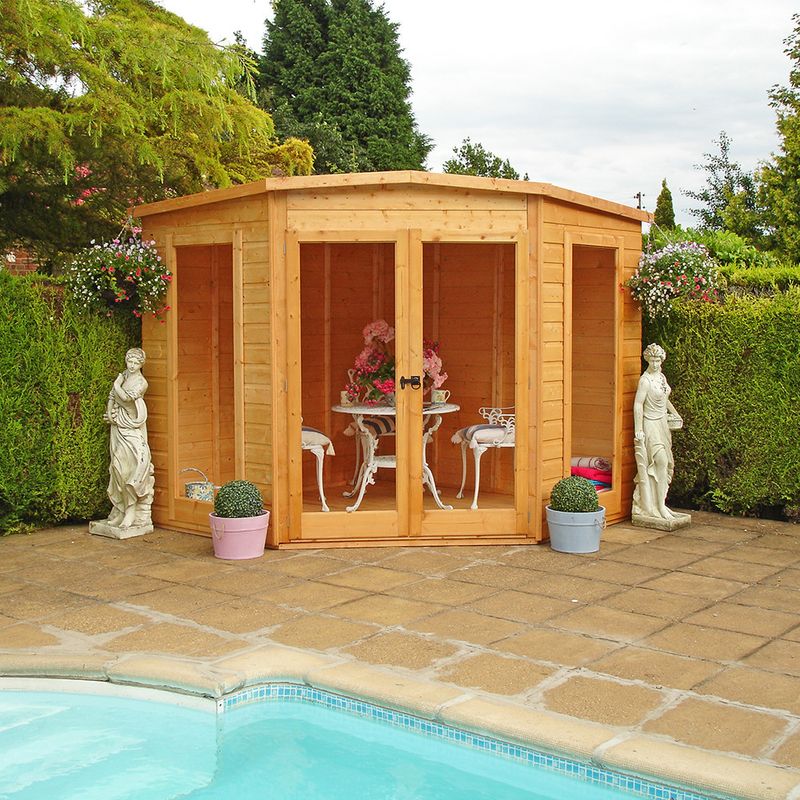
The right garden ornaments can make or break your garden! It’s not simply the style of your ornaments which needs to match that of your other landscaping elements, though.
The thing is:
According to the latest UK garden design ideas, you also need the right-sized ornaments to enhance your garden’s sense of scale and proportion. Too little, and they’ll simply be lost in the background. Too large, and they’ll draw your eyes away from your intended focal point.
If you like the soothing sound of dripping water – and, yes, want to attract birds – consider a water feature alongside wildlife garden ornaments. Sure, garden gnomes are fine, but there are plenty of other alternatives you can choose from.
At the end of the day, just remember your ornaments need to match your overall design and don’t stand out unnecessarily.
9. Get the right garden lighting
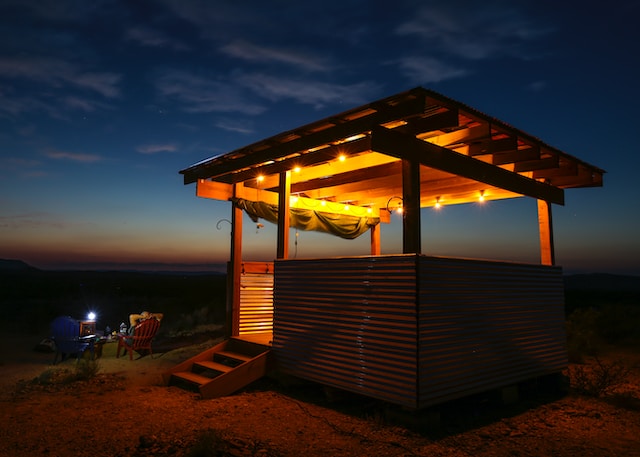
Speaking of the end of the day, you want to continue enjoying your garden design even after dark.
And unless you intend to channel your inner Hyacinth Bucket with al fresco candlelight suppers, you’re going to need the right garden lighting.
Enter garden design ideas. If you have trees, you can decorate them with string lights, providing light and enhancing your garden décor at the same time.
You can also add string lights to the outside of any summer house or other garden buildings. If you’re going for that quirky vibe, consider different colour light bulbs and varying wattage.
If you prefer a classic design, lanterns are an easy yet highly effective way to add effortless elegance, while garden spotlights will allow you to – yes, you guessed it – spotlight any landscaping feature you wish to focalise.
For the best effect, we recommend that you mix and match different types of garden lighting. This way, you’ll be able to get the right ambience and elevate your nighttime garden experience even further.
For more garden lighting ideas and inspiration, check out our dedicated guide.
10. Create a gravel garden
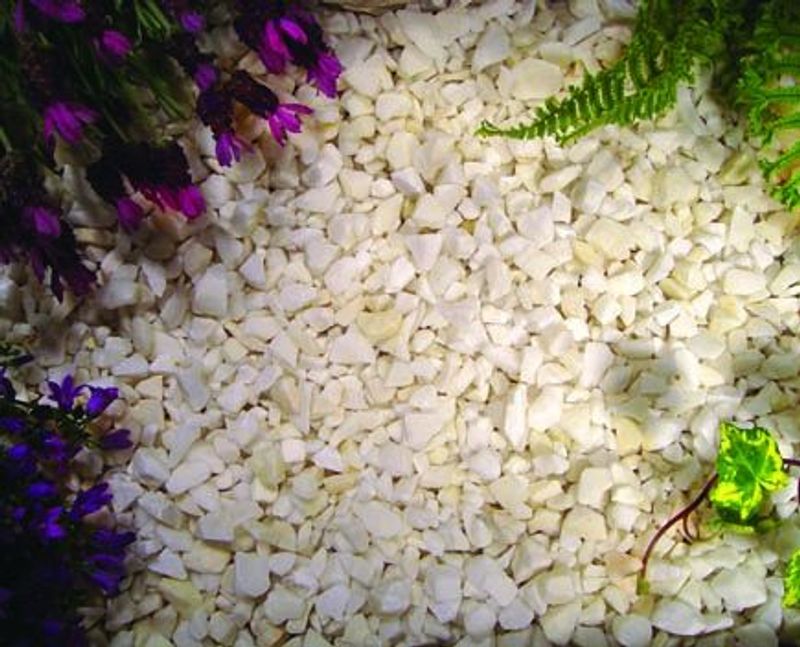
Gravel is often dismissed in contemporary gardens due to perceptions of being dull and monotonous, both in appearance and significance.
This is a huge mistake!
In fact, creating a gravel garden has to be one of our favourite garden makeover ideas.
Additionally, garden gravel designs have undergone significant advancements, with modern gravel garden ideas gaining immense popularity among engaged UK homeowners.
Consider decorative gravel and pebbles as an economical and remarkably chic alternative to conventional landscaping.
The best part?
A gravel garden comes with numerous advantages and hardly any drawbacks. It’s easy to lay and maintain, versatile and stylish, and it’s an easy way to improve garden drainage.
So, turn your garden into a captivating Mediterranean haven for leisure and entertainment by skilfully incorporating contemporary decorative gravel. And if you’re compartmentalising a larger garden, why not turn one of the spaces into a gravel garden corner?
11. Paint your fence for contrast
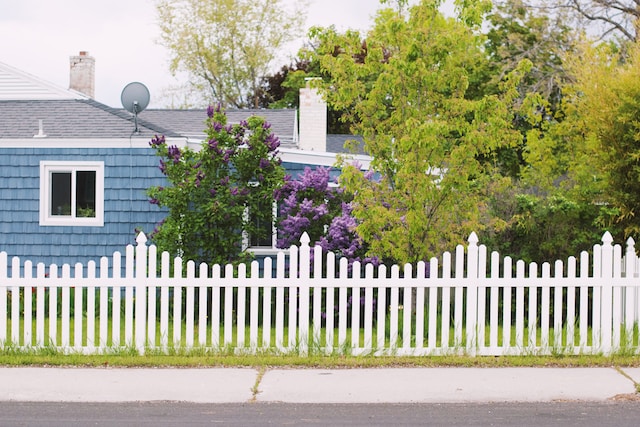
Introduce a bit of contrast to your garden by painting your fences. The spotless white picket fence is a classic that works really well against a freshly mowed verdant lawn, evoking the atmosphere of Wimbledon Centre Court.
That being said:
It’s far from the only option. Embrace the latest garden fence colour ideas, consider the role of colour psychology in design and think about the colour of your fence as yet another piece of your garden landscaping puzzle. If you want to create the illusion of space and make your garden appear bigger than it is, opt for light blue.
And if you’re feeling a bit more daring, a soft pink fence is ideal, as it’s guaranteed to dazzle in the sunset. Pale yellow is another inviting colour as well as the perfect foil for bright red or purple flowers.
Head over to our comprehensive guide for more garden fencing ideas and inspiration.
12. Bring warmth & elegance with a chiminea
A chiminea offers a charming and practical addition to any garden, offering warmth, comfort and a stunning focal point for gatherings and relaxation. It will provide a cosy and inviting source of warmth, making it perfect for chilly evenings and extending the usability of your garden during colder seasons.
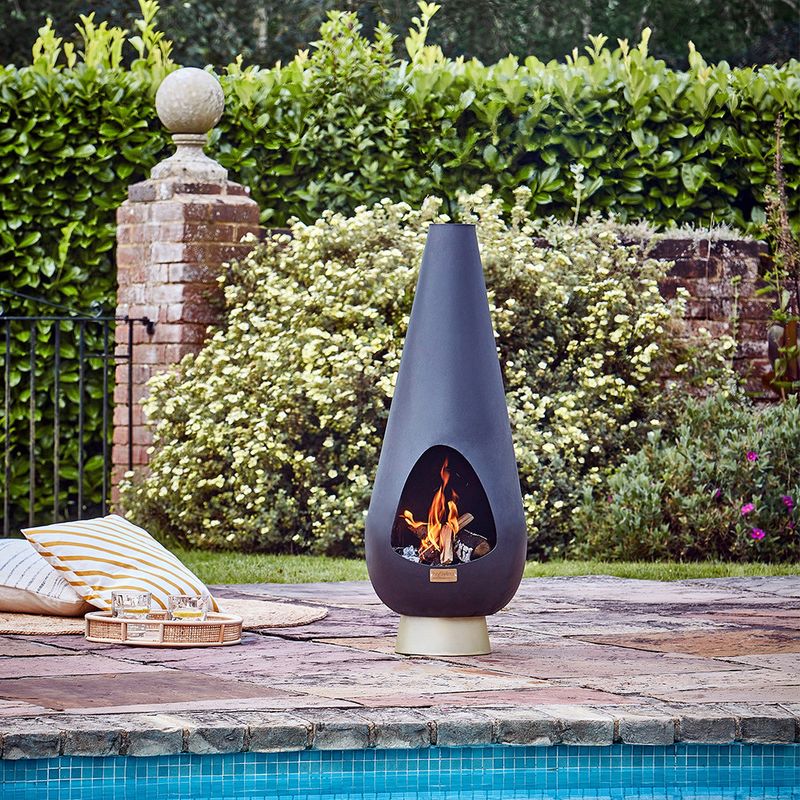
What’s more:
Many chimineas have a built-in grill or a cooking surface, allowing you to cook various foods, such as barbecue, pizza or marshmallows, right in your back garden. They also come in various styles and materials, ranging from traditional, Mesoamerican-inspired clay to contemporary cast iron and steel. So, they’re a neat complement to different kinds of gardening ideas.
Last but not least, chimineas are typically quite compact and take up less space than traditional fire pits or outdoor fireplaces, making them suitable for smaller gardens.
13. Embrace height with a trellis or pergola
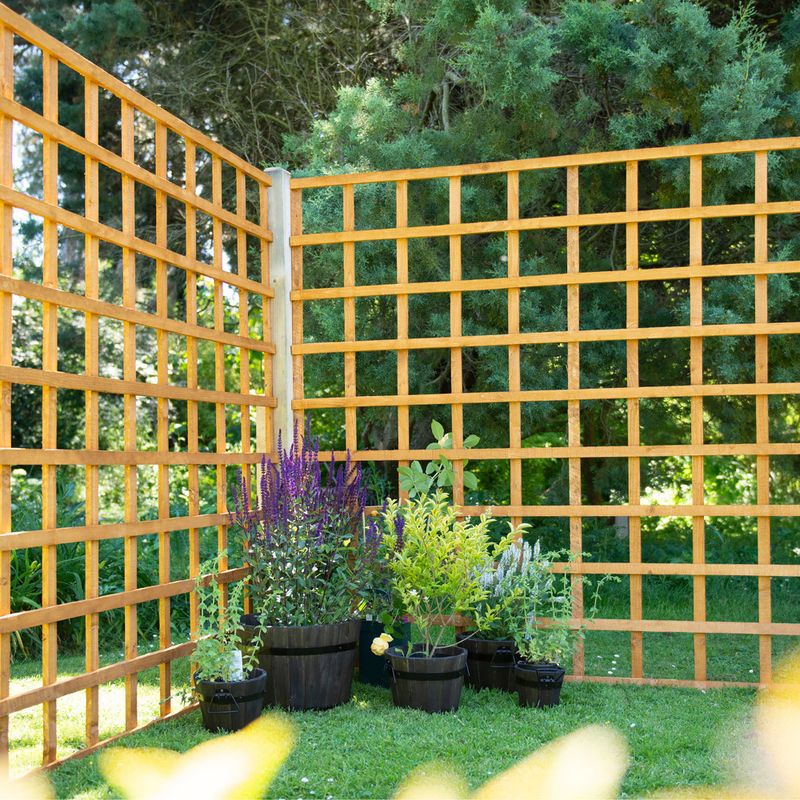
When designing a garden, many people tend to focus overwhelmingly on horizontal spaces.
This is a mistake. And here’s why:
A well-balanced garden needs to make the most of vertical as well as horizontal spaces to achieve better unity.
So, how do you do it?
Planting mature trees is one way to address this issue.
Another way is to install a trellis or two – either on existing garden walls or on its own – and create a mesmerising living wall with climbing plants like ivy or wisteria.
Like hedges, these living walls are not just aesthetically pleasing but ideal for compartmentalising larger gardens as well as maximising planting space in smaller gardens by embracing height.
Need more inspiration trellis ideas? We have a dedicated guide for that!
And that’s not all:
You can achieve a similar effect with a pergola. Climbing plants love them, and you can also hang potted plants from the rafters.
14. Create a holiday vibe with a hot tub
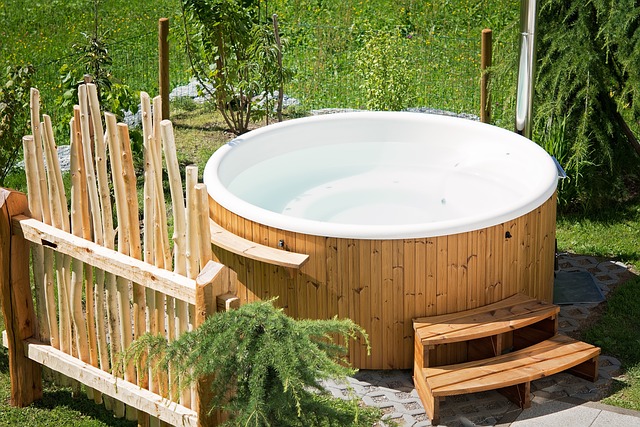
Whether or not you’re a fan of the screwball comedy Hot Tub Time Machine, you’re bound to appreciate a hot tub in your garden. And while it’s highly unlikely to transport you back in time, it’s guaranteed to create that unmistakable holiday vibe we all crave.
A hot tub in your garden can easily become a social focal point, providing a space for you to connect with family and friends. It’s an excellent setting for spending quality time together, engaging in conversations and creating lasting memories.
The benefits don’t end there:
Even if you’re not in the mood for partying, soaking in a hot tub can help you relax and unwind after a long, stressful day at work. The warm water and soothing jets can relieve muscle tension, reduce stress levels and promote a sense of calm and tranquillity. And with the right insulation and heating, hot tubs can be used year-round.
Let’s face it:
Garden design ideas don’t come much more fun than that!
Or do they?
15. Entertain in style with a garden bar
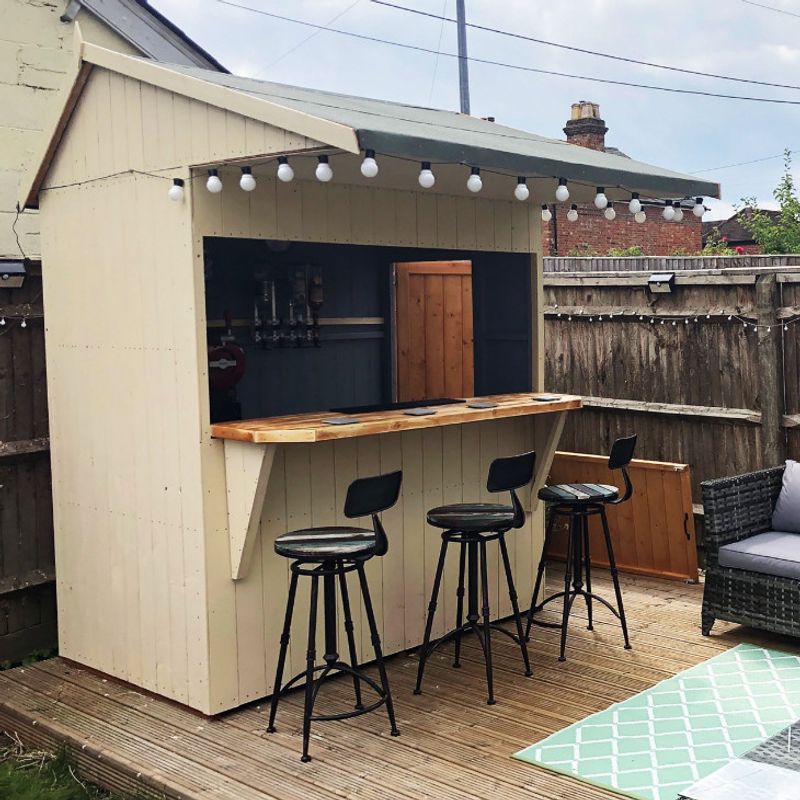
Last but certainly not least on our list of landscaping ideas is transforming your outdoor space into the ultimate beer garden.
Here’s the deal:
A garden bar is yet another natural focal point for your garden. And once you factor in a couple of bar stools, classic timber picnic tables and potted plants, you’re halfway there.
Your friends and family will doubtless be impressed, and your garden will quickly replace the local as the main hub of social activity and quality entertainment.
Picture this:
A warm, sunny Saturday afternoon in late June. You and your friends are sitting at the garden bar, enjoying a cold beverage and watching the tennis or cricket.
What could be better? Savour the image. And in the meantime, find even more inspiration with our exciting garden bar ideas.
Making the most of the latest garden landscaping ideas
With most of us stuck in our homes during the COVID-19 pandemic, many engaged homeowners eagerly took on multiple DIY garden improvement projects, learning quite a few things about how to design a garden in the process.
The good news is:
There’s plenty of garden landscaping inspiration to go around! Whether you’re looking to attract wildlife, entertain in style or do something else entirely, we have plenty of exciting garden design ideas you can try out.
Bottom line:
Remember the seven principles of landscaping design, plan carefully, gather the right tools and materials, and get ready to unleash your inner landscaper as you go about creating your dream garden.
